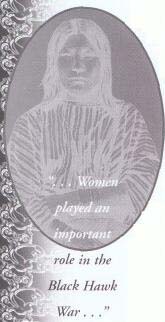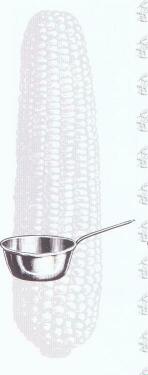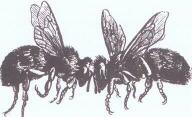|

|

Sauk and Mesquakie
Women in
Eighteenth-and
Nineteenth-Century
Northern Illinois
|
Linda Clemmons
Historical Research and Narrative
European and American explorers and settlers who encountered Native American women often characterized them as slaves to their husbands, drudges, and unadaptable to new and often challenging situations. For example, a woman named Allie B. Busby, who visited a Mesquakie (Fox) village for two summers in the late nineteenth century, described the women's lives in unflattering terms. In her memoir Two Summers among the Muskquakies..., she called the Fox women "debased," because they did the "most laborious of the work, often cutting wood and carrying it on their backs to the lodge, while the dusky braves to whom they are more than 'helpmeets' stay comfortably at home, probably engaged in card playing. ..." (109) She concluded that the Fox, like many other native peoples, did not respect or value women.
After reading accounts written by observers like Busby, some historians also have theorized that native women faced daily oppression. But the experience of the Sauk and Mesquakie women of northern Illinois, however, contradicts the negative views of observers and historians. Indeed, throughout the eighteenth and nineteenth century these women played an important economic role in their village subsistence patterns and successfully adapted to new economic realities after the arrival of fur traders and settlers. Moreover, Sauk and Mesquakie women occasionally assumed positions of power within their villages. Finally, women played an important role in the Black Hawk War (1832), after which the two tribes were permanently removed from the Illinois region into Iowa and beyond.
Both before and after contact with Euro-American traders and settlers, Sauk and Mesquakie women played an integral role in their villages' seasonal subsistence patterns. Throughout the eighteenth and early nineteenth centuries, the areas surrounding northern Illinois provided all of the food needed to sustain their villages. Black Hawk, a Sauk who would eventually take part in a fight for control of Indian lands in the early 1830s, called the area a "garden." In his Autobiography, he remembered that before white settlers began to encroach on Indian lands, "We always had plenty—our children never cried with hunger, nor our people were never in want." The Sauk and Mesquakie villages prospered because they based their subsistence patterns on the seasons, following a cyclical round of hunting, gathering, cultivating crops, fishing, and sugar-making.
Beginning in the late spring, the Sauk and Mesquakie settled their planting villages. At this time, they repaired their lodges, fences, and prepared their fields for planting. The women were in charge of all phases of cultivation (although men might help to prepare the soil), and they planted fields of corn, beans, squash, pumpkins, and melons. Most of the villages planted large fields. In his Autobiography Black Hawk reported that the women cultivated more than 800 acres in his village alone. After the crops had taken root and reached approximately knee-height, the villages split up for the summer months according to their gender. Groups of adult men left to hunt buffalo, elk, and deer on the prairies to the west. They also might fish, and summer was the time for war, especially against the Dakota (Sioux) to the north. While the men hunted or defended their territory, the women, children, and elderly departed from their villages to gather acorns, honey, roots, berries, fruits, nuts, and materials for making mats.
In early August, the Sauk and Mesquakie returned to their villages to harvest and store their now mature crops. At this time, the men and women also distributed the meat from their hunt and divided the gathered items. In addition, they held celebrations and religious ceremonies. Following the fall harvest, the village once again dispersed into smaller groups and moved westward for their winter hunt. During the harshest months of winter, the smaller hunting parties frequently reunited to wait for the spring thaw. In March, the men and women once again separated. The men left to trap and to hunt, while the women, children, and elderly traveled to their sugar camps to collect and process maple sugar. As with agriculture, the
|
2
|
Sauk and Mesquakie women controlled all phases of sugar making. After the maple-sugar making and hunts were complete, the Sauk and Mesquakie people returned once again to their villages to plant their spring crops. At this time, the seasonal subsistence cycle began once again,
Although the Sauk and Mesquakie men and women adapted their subsistence patterns to the environment, and both genders contributed equally to the survival of their villages, Euro-American observers like Allie B. Busby denounced the men as lazy and called the women slaves and drudges to their husbands. This negative characterization of Sauk and Mesquakie gender roles arose because the Indians divided their labor differently from their white counterparts. In the eighteenth and nineteenth centuries, Euro-Americans expected men to perform the majority of farm labor, while the women cared for their homes and children. At the same time, many Euro-Americans viewed hunting as more of a sport than as a serious form of labor. Thus, white observers frequently denounced Fox and Mesquakie men for making their women perform the difficult task of farming while they "played" at hunting or card games.
These commentators, however, failed to take into account the physically exhausting nature of hunting, or that the women did not consider themselves to be slaves to their husbands. Indeed, in my study of Dakota relations with Protestant missionaries, I found evidence that that Dakota women refused to listen to the missionaries and renounce farming because they took pride in their labor and did not view planting as mere "drudgery." Even when given the chance at "liberation," Dakota women continued to plant as they had done before.
In addition to disregarding native women's own evaluations of their gender roles, many Euro-American observers also neglected to take other forms of women's political power into account when they called women "slaves" to their husbands. For example, Sauk and Mesquakie women played crucial roles in their village councils, where important decisions were made. Lucy Eldersveld Murphy, in A Gathering of Rivers, argues that although the men generally took charge of the village councils, Sauk and Mesquakie women exercised power behind the scenes. When the male council members debated an issue, the women voiced their opinions and made it clear that they would not support unpopular decisions, If the council wanted its resolutions enforced, they could not afford to neglect the women's views. In some cases, the women might even hold their own formal or informal council meetings.
Historian Tanis Thorne, in "For the Good of her People: Continuity and Change for Native Women of the Midwest," also found references to Sauk and Mesquakie women who became chiefs and spiritual leaders of their villages in their own right. This generally occurred when a male relative died and his wife or daughter took over the position. Even if she had gained power because of her relationship to a male, however, the new female chief could not retain her position if she was not a powerful orator and a forceful leader.
Along a similar line, Murphy and Thorne both give examples of Sauk and Mesquakie women who actively participated in (and even initiated) diplomacy with other tribes and with Euro-Americans. For example, in "Autonomy and the Economic Roles of Indian Women of the Fox-Wisconsin River Region, 1763-1832," Murphy opened her article with the story of a group of women who approached an American government official to complain about the United States' decision to remove them from their village of Saukenuk. The women strongly protested the removal because it would take them away from their summer farming villages. Although the agent dismissed them because of their gender, the women pressed their case because the agent's order directly challenged their subsistence patterns.
That women, like the delegation from Saukenuk, protested against removal and other injustices, however, does not mean that they could not adapt to new situations brought by contact with Euro-American fur traders and settlers. In fact, the historical record shows that Sauk and Mesquakie women adeptly integrated new trading patterns into their traditional seasonal routine and economic activities.
As Murphy and Thorne persuasively argue, even before contact with Euro-Americans, Sauk and Mesquakie women had actively participated in trade networks. For example, they traded surplus items they produced, such as agricultural products, medicines, and woven mats to other native peoples. When European traders arrived in the seventeenth century, native women simply increased their traditional production and continued to trade surplus products just as they had in pre-contact times. The women supplied the traders with corn, maple sugar, clothing, crafts, feathers, and woven mats. In return, they received coveted items from the traders, including cooking utensils, knives, blankets, and decorative items such as beads.
Sauk and Mesquakie women also supplied the traders with lead. Since pre-contact times, mining lead had been the province of the women. During the summer, some women (along with elderly men) would visit the mines near the Mississippi and extract small quantities of lead, which they used for decoration and in some of their religious ceremonies. They also traded some of their product to other
|

|
3

|
native peoples, located as far away as the American southwest and even into Canada. With the arrival of European firearms, however, the importance of lead to both native peoples and Europeans rose dramatically. As a result, women increased their summer mining production so that their own communities could have the lead for bullets. This growing extraction, however, also gave the women another product that they could trade to EuroAmericans.
Despite the fact that male-gathered furs formed the backbone of the trade empire, the important role that women played in the trading system cannot be overestimated. Indeed, historian Tanis Thorne goes so far as to say that without women's efforts in producing and trading their surplus products, the acquisition of desired Euro-American trade goods would not have been possible. The amount of goods that women produced and traded by the early nineteenth century certainly backs up this statement. For example, Thorne notes that in 1820, women living near the trading village of Prairie du Chien produced 8,000 bushels of corn, of which they sold 1,000 bushels to the white traders and settlers. Throughout the eighteenth and early nineteenth century, women adapted their traditional subsistence patterns, including agricultural production and lead mining, to the new economic situation brought by Euro-Americans.
Although native women continued to participate in the trading system, the early nineteenth century brought new (and ultimately insurmountable) challenges. In the 1820s, white settlers and miners began to arrive in Illinois. Instead of making an effort to coexist or trade with the native inhabitants, the two groups commonly clashed over resources and land between them. For example, in his Autobiography, Black Hawk remembered some of the violent confrontations he experienced with the growing number of Americans. One time, Black Hawk reported that he was hunting raccoons when he met three white settlers. The men accused him of stealing their hogs. Although Black Hawk vehemently denied the charges, the men beat him with sticks and demanded that he leave the area. This was not an isolated incident. Another time, Black Hawk told of a member of his village who had cut down a tree to gather honey. Soon, white men arrived and told him that the tree belonged to them. Black Hawk's friend offered to return the honey that he had collected, but the settlers refused and demanded further compensation. In the end, the three white men ended up taking all of the man's furs in payment for the tree.
As the conflicts escalated, the white settlers began to demand that the United States negotiate a series of treaties with the Sauk and Mesquakie for their remaining lands in Illinois and remove them across the Mississippi River. In 1827, the Illinois governor responded to the wishes of his constituents and asked the Department of War, which controlled Indian affairs at this time, to remove the Sauk and Mesquakie from his state. In 1829, the Secretary of War agreed to the governor's request, and ordered both tribes to vacate Illinois. One faction of the tribe, led by Keokuk, agreed to remove into Iowa. Another group, led by the Sauk Black Hawk, however, refused to leave Illinois and attempted to return to their planting villages in 1832.
Although Black Hawk's supporters consisted of both genders, women became some of his strongest allies. As historian Lucy Eldersveld Murphy points out, the women's refusal to leave Illinois was directly linked to their subsistence patterns. Moreso than the men, who often ranged over long distances in their hunts, the women were tied to the Illinois land. They planted their corn in their villages every year, visited the same sugar groves, and mined Illinois lead. Removal would have required them to give up some of their economic status within their own communities, as well as their power with the Euro-American traders. As such, Sauk and Mesquakie women played a prominent role in defending their land, homes, and economic livelihoods.
Despite the women's support, Black Hawk was outnumbered militarily, and he lost what became known as the "Black Hawk War." As a result, even though most Sauk and Mesquakie had remained neutral, all were forced to sign treaties requiring them to give up all of their lands east of the Mississippi and confining them to a small reservation in Iowa. United States officials also used the war as an excuse to demand land cessions from tribes such as the Winnebagos who had refused to ally with Black Hawk. After the lost war and their subsequent removal from Illinois, the Sauk and Mesquakie spent thirteen years in Iowa, where their population declined precipitously as a result of disease and starvation. Historian William T. Hagan, in The Sac and Fox Indians, reported that the annual death rate exceeded the birth rate by about 300 in the decades following the Black Hawk War.
The tragedies of war and removal, however, should not obscure the accomplishments of Illinois native women. Throughout the

|
eighteenth and nineteenth centuries, Sauk and Mesquakie women played integral roles in the political and economic lives of their villages and proved to be both adaptable and willing to fight for their rights. Assuredly, these women continued to adjust to their changing conditions of reservation life, as they had done for the previous centuries both before and after the arrival of Euro-Americans. The story of Sauk and Mesquakie women illustrates that the remarks of Euro-American observers, like Allie B. Busby, should not be taken at face value. More often than not these commentators did not understand American Indian gender roles, and ignored the multiple, essential, and occasionally powerful roles that native women played within their own communities.
Click here for Curriculum Materials
|

